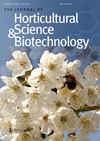小气候和光合作用对温室草莓生殖生长的影响——以叶片累积光合作用为指标预测收获期
IF 2.1
4区 农林科学
Q2 HORTICULTURE
Journal of Horticultural Science & Biotechnology
Pub Date : 2023-09-10
DOI:10.1080/14620316.2023.2254759
引用次数: 0
摘要
我们评价了累积光合作用(An,C)作为预测草莓收获期的指标是否比光(IC)或温度(Ta,C)更好。我们在日本的一个温室里监测了超过2700种水果在整个生长季节开花、结实和收获的日常动态。光合作用是用生化模型计算的,An,C是通过计算每个果实从开花到收获的累积速率来计算的。IC和Ta、C由日累计光照强度和平均温度计算。定义一个新的指数(D)为An,C, IC和Ta,C的归一化变化,并对每个指数的平均值进行统计分析。结果表明,a、C的D值最低(0.114),是较好的预测收获期指标。本研究表明,考虑单果光合产物积累的重要性,这是IC或Ta,C无法实现的,这些结果可用于提高产量的预测和优化。然而,需要进一步的研究来证实这些说法。本文章由计算机程序翻译,如有差异,请以英文原文为准。
Effect of microclimate and photosynthesis on strawberry reproductive growth in a greenhouse: using cumulative leaf photosynthesis as an index to predict the time of harvest
We evaluate whether cumulative photosynthesis (An,C) could predict the time of harvest in strawberry better than light (IC) or temperature (Ta,C) as forecast indices. We monitored the daily dynamics of flowering, fruit set, and harvest in over 2,700 fruits across the growing season in a greenhouse in Japan. Photosynthesis was calculated using a biochemical model, and An,C calculated by totalling the cumulative rate from flowering to harvest in each fruit. IC and Ta,C were calculated by totalling daily cumulative light intensity and average temperature. A new index (D) was defined as the normalised variation of An,C, IC, and Ta,C, and a statistical analysis was conducted on the means for each index. The results showed that An,C had the lowest D (0.114), suggesting that it was a better index for predicting the time of harvest. This study suggests the importance of considering the accumulation of photosynthates in individual fruit, which cannot be achieved by IC or Ta,C, these results can be used to improve the forecasting and optimisation of yield. However, further research is required to substantiate these claims.
求助全文
通过发布文献求助,成功后即可免费获取论文全文。
去求助
来源期刊
CiteScore
3.90
自引率
5.30%
发文量
67
审稿时长
3 months
期刊介绍:
The Journal of Horticultural Science and Biotechnology is an international, peer-reviewed journal, which publishes original research contributions into the production, improvement and utilisation of horticultural crops. It aims to provide scientific knowledge of interest to those engaged in scientific research and the practice of horticulture. The scope of the journal includes studies on fruit and other perennial crops, vegetables and ornamentals grown in temperate or tropical regions and their use in commercial, amenity or urban horticulture. Papers, including reviews, that give new insights into plant and crop growth, yield, quality and response to the environment, are welcome, including those arising from technological innovation and developments in crop genome sequencing and other biotechnological advances.

 求助内容:
求助内容: 应助结果提醒方式:
应助结果提醒方式:


